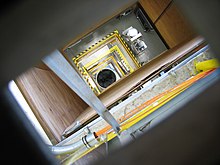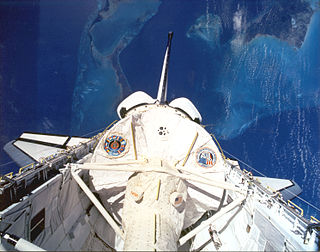
STS-50 was a NASA Space Shuttle mission, the 12th mission of the Columbia orbiter. Columbia landed at Kennedy Space Center for the first time ever due to bad weather at Edwards Air Force Base caused by the remnants of Hurricane Darby.
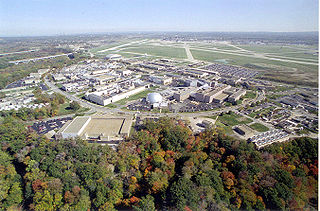
NASA John H. Glenn Research Center at Lewis Field is a NASA center within the cities of Brook Park and Cleveland between Cleveland Hopkins International Airport and the Rocky River Reservation of Cleveland Metroparks, with a subsidiary facility in Sandusky, Ohio. Its director is James A. Kenyon. Glenn Research Center is one of ten major NASA facilities, whose primary mission is to develop science and technology for use in aeronautics and space. As of May 2012, it employed about 1,650 civil servants and 1,850 support contractors on or near its site.

A reduced-gravity aircraft is a type of fixed-wing aircraft that provides brief near-weightless environments for training astronauts, conducting research, and making gravity-free movie shots.

STS-65 was a Space Shuttle program mission of Columbia launched from Kennedy Space Center, Florida, 8 July 1994. The flight carried a crew of 7 and was commanded by Robert D. Cabana who would go on later to lead the Kennedy Space Center. STS-65 was an international science mission that carried the International Microgravity Laboratory (IML-2) on an 15-day mission. Columbia returned to the Kennedy Space Center on 23 July 1994.
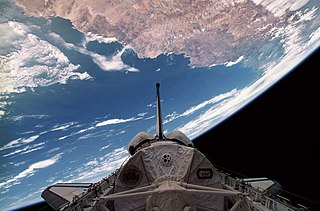
STS-73 was a Space Shuttle program mission, during October–November 1995, on board the Space Shuttle Columbia. The mission was the second mission for the United States Microgravity Laboratory. The crew, who spent 16 days in space, were broken up into 2 teams, the red team and the blue team. The mission also included several Detailed Test Objectives or DTO's.

STS-83 was a NASA Space Shuttle mission flown by Columbia. It was a science research mission that achieved orbit successfully, but the planned duration was a failure due to a technical problem with a fuel cell that resulted in the abort of the 15 day duration. Columbia returned to Earth just shy of four days. The mission was re-flown as STS-94 with the same crew later that year.

STS-94 was a mission of the United States Space Shuttle Columbia, launched on 1 July 1997.
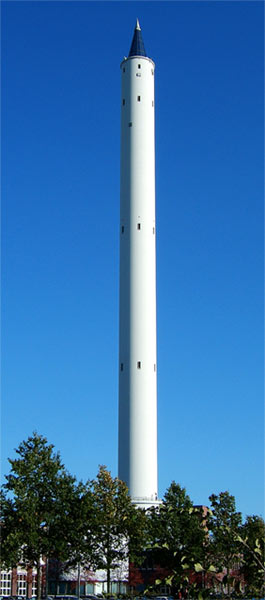
Fallturm Bremen is a drop tower at the Center of Applied Space Technology and Microgravity at the University of Bremen in Bremen. It was built between 1988 and 1990, and includes a 122-metre-high drop tube, in which for 4.74 seconds, or for over 9 seconds weightlessness can be produced. The entire tower, formed out of a reinforced concrete shank, is 146 metres high.

Zero Gravity Corporation is an American company based in Exploration Park, Florida, formerly of Fort Lauderdale, Florida, which operates weightless flights from United States airports. Zero-G is governed under Part 121 of FAA regulations enabling the company to cater to both tourists and researchers alike. Zero-G is operated by Everts Air Cargo who holds the 121 certificate.

Artificial gravity is the creation of an inertial force that mimics the effects of a gravitational force, usually by rotation. Artificial gravity, or rotational gravity, is thus the appearance of a centrifugal force in a rotating frame of reference, as opposed to the force experienced in linear acceleration, which by the equivalence principle is indistinguishable from gravity. In a more general sense, "artificial gravity" may also refer to the effect of linear acceleration, e.g. by means of a rocket engine.

The Space Systems Laboratory (SSL) is part of the Aerospace Engineering Department and A. James Clark School of Engineering at the University of Maryland in College Park, Maryland. The Space Systems Laboratory is centered on the Neutral Buoyancy Research Facility, a 50-foot-diameter (15 m), 25-foot-deep (7.6 m) neutral buoyancy pool used to simulate the microgravity environment of space. The only such facility housed at a university, Maryland's neutral buoyancy tank is used for undergraduate and graduate research at the Space Systems Lab. Research in Space Systems emphasizes space robotics, human factors, applications of artificial intelligence and the underlying fundamentals of space simulation. There are currently five robots being tested, including Ranger, a four-armed satellite servicing robot, and SCAMP, a six-degree of freedom free-flying underwater camera platform. Ranger was funded by NASA starting in 1992, and was to be a technological demonstration of orbital satellite servicing. NASA was never able to manifest it for launch and the program was defunded circa 2006. For example, Ranger development work at the SSL continues, albeit at a slower pace; Ranger was used to demonstrate robotic servicing techniques for NASA's proposed robotic Hubble Servicing Mission.

The Zero Gravity Research Facility at the NASA Glenn Research Center, in Cleveland, Ohio, is a unique facility designed to perform tests in a reduced gravity environment. It has successfully supported research for United States crewed spacecraft programs and numerous uncrewed projects. The facility uses vertical drop tests in a vacuum chamber to investigate the behavior of systems, components, liquids, gases, and combustion in microgravity.

Weightlessness is the complete or near-complete absence of the sensation of weight, i.e., zero apparent weight. It is also termed zero g-force, or zero-g or, incorrectly, zero gravity.

The International Space Station is a platform for scientific research that requires one or more of the unusual conditions present in low Earth orbit. The primary fields of research include human research, space medicine, life sciences, physical sciences, astronomy and meteorology. The 2005 NASA Authorization Act designated the American segment of the International Space Station as a national laboratory with the goal of increasing the use of the ISS by other federal agencies and the private sector.

The Combustion Integrated Rack (CIR) is an experiment facility installed in the International Space Station (ISS). It includes an optics bench, combustion chamber, fuel and oxidizer control, and five different cameras for performing combustion experiments in microgravity.
ELIPS - European Programme for Life and Physical Sciences in Space and applications utilising the International Space Station started in 2001 and was intended to cover the activities for the following 5 years. This Microgravity Programme at the European Space Agency (ESA) is an optional programme, with currently 17 ESA member states participating. The ELIPS programme prepares and performs research on the International Space Station, and other uncrewed mission platforms like Sounding Rockets, in fundamental and applied life and physical sciences. ELIPS is the continuation of the earlier European microgravity programmes EMIR 1&2, and the Microgravity Facilities for Columbus, MFC.
Dropping In Microgravity Environment (DIME) is an annual contest held by NASA's Glenn Research Center. Teams of high school students, with one "faculty adviser", from anywhere in the United States or its territories can enter. The teams prepare and submit proposals for research to be performed; four teams are selected to travel to the Glenn Research Center and perform their experiments at the Zero Gravity Research Facility, in the "drop tower", a deep shaft that can be completely depressurized and thus simulate microgravity when an object is in free fall in it. A further four teams' experiments are selected and conducted by the Center staff. The teams are responsible for writing their proposals, assembly of the necessary equipment if their experiments are chosen to be performed, testing of the setups at their respective homes, and preparation and submission of reports to NASA about their results.

Neutral buoyancy simulation with astronauts immersed in a neutral buoyancy pool, in pressure suits, can help to prepare astronauts for the difficult task of working while outside a spacecraft in an apparently weightless environment.

Vladimir Pletser is Director of Space Training Operations at Blue Abyss since 2018, where he is in charge of developing astronaut training programs. From 2016 to early 2018, he was a Visiting Professor and Scientific Adviser at the Technology and Engineering Centre for Space Utilization (CSU) of the Chinese Academy of Sciences in Beijing, China. He supported the preparation of scientific experiments in microgravity for the Chinese Tiangong space station and for aircraft parabolic flights. He worked previously from 1985 till early 2016 as a senior Physicist Engineer at the European Space Research and Technology Centre (ESTEC) of ESA.

Astronaut training describes the complex process of preparing astronauts in regions around the world for their space missions before, during and after the flight, which includes medical tests, physical training, extra-vehicular activity (EVA) training, procedure training, rehabilitation process, as well as training on experiments they will accomplish during their stay in space.

